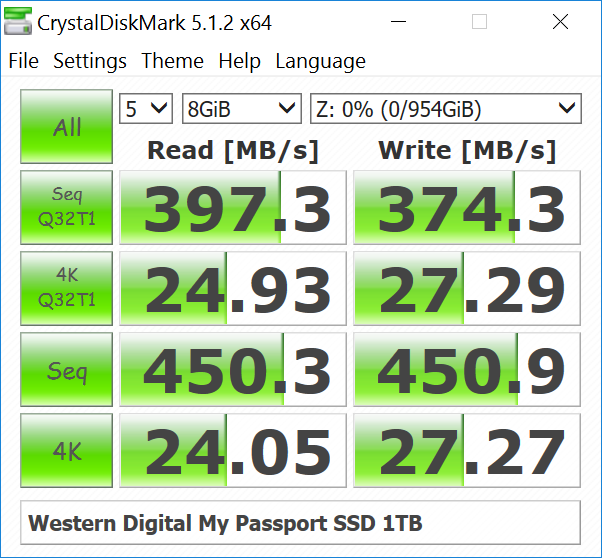Western Digital My Passport SSD Mini-Review
by Ganesh T S on June 28, 2017 8:00 AM EST- Posted in
- Storage
- SSDs
- Western Digital
- DAS
- USB 3.1
Synthetic Benchmarks
Various synthetic benchmarks are available to quickly evaluate the performance of direct-attached storage devices. Real-world performance testing often has to be a customized test. We present both varieties in this review, starting with the synthetic benchmarks in this section. Prior to covering those, we have a quick look at our testbed setup and testing methodology.
Testbed Setup and Testing Methodology
Evaluation of DAS units on Windows is done with the testbed outlined in the table below. For devices with a USB 3.1 Gen 2 (via a Type-C interface) connections (such as the WD My Passport SSD 1TB that we are considering today), we utilize the USB 3.1 Type-C port enabled by the Intel Alpine Ridge controller. It connects to the Z170 PCH via a PCIe 3.0 x4 link..
| AnandTech DAS Testbed Configuration | |
| Motherboard | GIGABYTE Z170X-UD5 TH ATX |
| CPU | Intel Core i5-6600K |
| Memory | G.Skill Ripjaws 4 F4-2133C15-8GRR 32 GB ( 4x 8GB) DDR4-2133 @ 15-15-15-35 |
| OS Drive | Samsung SM951 MZVPV256 NVMe 256 GB |
| SATA Devices | Corsair Neutron XT SSD 480 GB Intel SSD 730 Series 480 GB |
| Add-on Card | None |
| Chassis | Cooler Master HAF XB EVO |
| PSU | Cooler Master V750 750 W |
| OS | Windows 10 Pro x64 |
| Thanks to Cooler Master, GIGABYTE, G.Skill and Intel for the build components | |
The full details of the reasoning behind choosing the above build components can be found here. The list of DAS units used for comparison purposes is provided below.
- WD My Passport SSD 1TB
- ADATA SD700 512GB
- Corsair Voyager GS 512GB
- G-DRIVE slim SSD USB-C 500GB
- Samsung Portable SSD T1 1TB - No Encryption
- Samsung Portable SSD T3 2TB
- SanDisk Extreme 900 1.92TB
ATTO and Crystal DiskMark
Western Digital claims speeds of up to 515 MBps. With the ATTO Disk Benchmark, we were able to get close to 470 MBps read speeds. Unfortunately, these access traces are not very common in real-life scenarios.

CrystalDiskMark, despite being a canned benchmark, provides a better estimate of the performance range with a selected set of numbers. As evident from the screenshot below, the performance can dip to as low as 24 MBps for 4K random accesses (but, such accesses are seldom encountered in the typical usage scenario of external storage devices).

Compared to the other external SSDs whose 4K numbers at high queue depths are a significant multiple of the 4K @ QD1, we find that the My Passport SSD's numbers are approximately the same. This usually points to UASP not being enabled in the firmware of the bridge chip.










22 Comments
View All Comments
bignazpwns - Saturday, July 15, 2017 - link
It's a nice drive. The black plastic feels and looks cheap but one screw is all it takes to crack it open. Uses a m.2 drive that's just 2 sided taped down. Easy to pop out and put it in a Mobo's m.2 slot and 550/540 so not to bad. The issue is with the controller on the m.2 to USB interface. But on sale this is a nice source or a cheap 1tb m.2 drive. I'll check the USB to m.2 board with a NVME drive to see how much it slows that down. But it's a nice drive and is much better then the Samsung that uses a junk msata drive and the SanDisk that uses. Normal sata drive in a small enclosure. And I will confirm the drive in the WD is a SanDisk and works in a Mobo m.2 slot without doing anything extra. And for those why want to do the swap. There are 2 small 2 sided tape squaresNathanks - Tuesday, July 10, 2018 - link
Can you do the review again with current intel 8th gen board with usb 3.1 gen -2 i believe old board is limited to gen 1. which is 5gbps